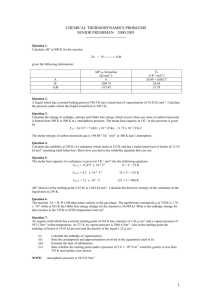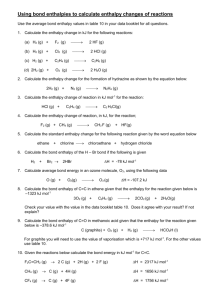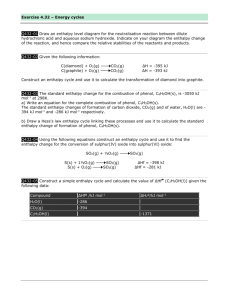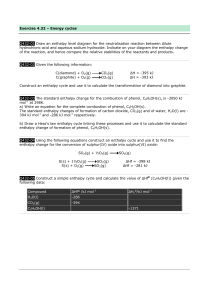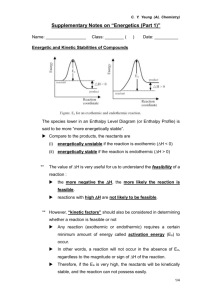1: THERMODYNAMICS
advertisement
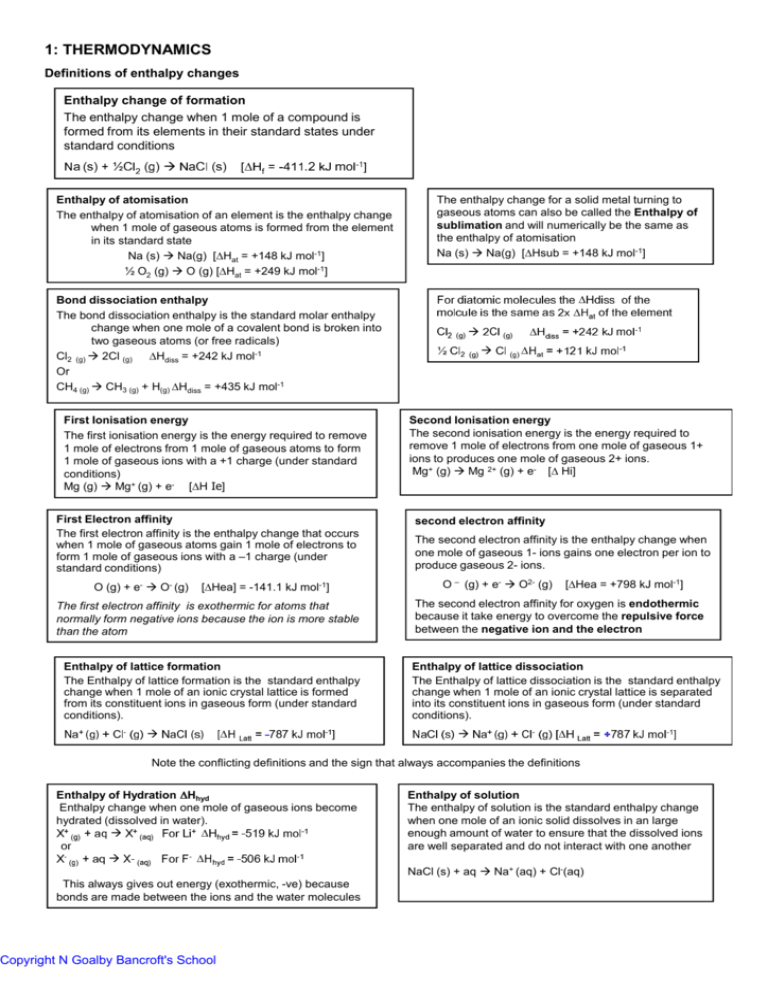
1: THERMODYNAMICS Definitions of enthalpy changes Enthalpy change of formation The enthalpy change when 1 mole of a compound is formed from its elements in their standard states under standard conditions Na (s) + ½Cl2 (g) NaCl (s) [∆Hf = -411.2 kJ mol-1] Enthalpy of atomisation The enthalpy of atomisation of an element is the enthalpy change when 1 mole of gaseous atoms is formed from the element in its standard state Na (s) Na(g) [∆Hat = +148 kJ mol-1] ½ O2 (g) O (g) [∆Hat = +249 kJ mol-1] The enthalpy change for a solid metal turning to gaseous atoms can also be called the Enthalpy of sublimation and will numerically be the same as the enthalpy of atomisation Na (s) Na(g) [∆Hsub = +148 kJ mol-1] Bond dissociation enthalpy The bond dissociation enthalpy is the standard molar enthalpy change when one mole of a covalent bond is broken into two gaseous atoms (or free radicals) Cl2 (g) 2Cl (g) ∆Hdiss = +242 kJ mol-1 Or CH4 (g) CH3 (g) + H(g) ∆Hdiss = +435 kJ mol-1 For diatomic molecules the ∆Hdiss of the molcule is the same as 2x ∆Hat of the element Cl2 (g) 2Cl (g) ∆Hdiss = +242 kJ mol-1 ½ Cl2 (g) Cl (g) ∆Hat = +121 kJ mol-1 First Ionisation energy The first ionisation energy is the energy required to remove 1 mole of electrons from 1 mole of gaseous atoms to form 1 mole of gaseous ions with a +1 charge (under standard conditions) Mg (g) Mg+ (g) + e- [∆H Ie] First Electron affinity The first electron affinity is the enthalpy change that occurs when 1 mole of gaseous atoms gain 1 mole of electrons to form 1 mole of gaseous ions with a –1 charge (under standard conditions) O (g) + e- O- (g) [∆Hea] = -141.1 kJ mol-1] The first electron affinity is exothermic for atoms that normally form negative ions because the ion is more stable than the atom Second Ionisation energy The second ionisation energy is the energy required to remove 1 mole of electrons from one mole of gaseous 1+ ions to produces one mole of gaseous 2+ ions. Mg+ (g) Mg 2+ (g) + e- [∆ Hi] second electron affinity The second electron affinity is the enthalpy change when one mole of gaseous 1- ions gains one electron per ion to produce gaseous 2- ions. O – (g) + e- O2- (g) [∆Hea = +798 kJ mol-1] The second electron affinity for oxygen is endothermic because it take energy to overcome the repulsive force between the negative ion and the electron Enthalpy of lattice formation The Enthalpy of lattice formation is the standard enthalpy change when 1 mole of an ionic crystal lattice is formed from its constituent ions in gaseous form (under standard conditions). Enthalpy of lattice dissociation The Enthalpy of lattice dissociation is the standard enthalpy change when 1 mole of an ionic crystal lattice is separated into its constituent ions in gaseous form (under standard conditions). Na+ (g) + Cl- (g) NaCl (s) [∆H Latt = -787 kJ mol-1] NaCl (s) Na+ (g) + Cl- (g) [∆H Latt = +787 kJ mol-1] Note the conflicting definitions and the sign that always accompanies the definitions Enthalpy of Hydration ∆Hhyd Enthalpy change when one mole of gaseous ions become hydrated (dissolved in water). X+ (g) + aq X+ (aq) For Li+ ∆Hhyd = -519 kJ mol-1 or X- (g) + aq X- (aq) For F- ∆Hhyd = -506 kJ mol-1 This always gives out energy (exothermic, -ve) because bonds are made between the ions and the water molecules Copyright N Goalby Bancroft's School Enthalpy of solution The enthalpy of solution is the standard enthalpy change when one mole of an ionic solid dissolves in an large enough amount of water to ensure that the dissolved ions are well separated and do not interact with one another NaCl (s) + aq Na+ (aq) + Cl-(aq) BORN HABER CYCLES The lattice enthalpy cannot be determined directly. We calculate it indirectly by making use of changes for which data are available and link them together in an enthalpy cycle the Born Haber cycle Born Haber cycle: sodium Chloride Na (g) + e+ + Pay attention to state symbols and direction of arrows. Cl (g) ∆HEa(Cl) ∆Hat (Cl) Usually all pieces of data are given except the one that needs to be calculated Na (g) + Cl (g) + Na (g) + e- + ½ Cl2(g) + ∆HIE 1(Na) - ∆H lattice (NaCl) Na (g) + ½ Cl2(g) ∆Hat (Na) Na (s) + ½ Cl2(g) ∆Hf (NaCl) NaCl (s) By applying hess’s law the heat of formation equals to the sum of everything else ∆Hf =∆HatNa + ∆HIENa+ ∆HatCl + ∆HEaCl + ∆Hlatt Rearrange to give ∆Hlatt = ∆Hformation - (∆HatmNa + ∆HIENa + ∆HatmCl + ∆HEaCl ) ∆Hlattice =-411 – (+107 + 496 + 122 + -349) = -787 kJmol-1 Born Haber cycle: magnesium Chloride Mg (g) + 2e- + 2+ 2Cl (g) 2x ∆Hat (Cl) Mg (g) + 2e + Cl2(g) 2+ 2 x∆HEa(Cl) Mg (g) + 2Cl (g) 2+ - ∆HIE 2(Mg) Mg (g) + e- + Cl2(g) + ∆HIE 1(Mg) ∆H lattice Mg (g) + Cl2(g) ∆Hat (Mg) Mg (s) + Cl2(g) ∆Hf (MgCl2) Copyright N Goalby Bancroft's School MgCl2 (s) The data for the ∆Hat (Cl) could also be given as the bond energy for E(Cl-Cl ) bond. Remember : E(Cl-Cl ) = 2 x ∆Hat (Cl) Born Haber cycle: calcium oxide Ca (g) + 2e + 2+ - Ca (g) + O2 (g) 2+ O (g) ∆HEa1(O) ∆Hat (O) Notice the second electron affinity for oxygen is endothermic because it take energy to overcome the repulsive force between the negative ion and the electron - ∆HEa2(O) Ca (g) + e- + O (g) Ca (g) + 2e- + ½ O2(g) 2+ 2+ - ∆HIE 2(Ca) Ca (g) + e- + ½ O2(g)) + ∆HIE 1(Ca) ∆H lattice Ca (g) + ½ O2(g) ∆Hat (Ca) Ca (s) + ½ O2(g) ∆Hf (CaO) CaO (s) Trends in Lattice Enthalpies The lattice enthalpies become less negative down any group. e.g. LiCl, NaCl, KCl, RbCl The strength of a lattice enthalpy depends on the following factors 1. 2. The sizes of the ions: e.g group 1 halides (eg NaF KI) have lattice enthalpies of around –700 to 1000 group 2 halides (eg MgCl2) have lattice enthalpies of around –2000 to –3500 group 2 oxides eg MgO have lattice enthalpies of around –3000 to –4500 kJmol-1 The larger the ions, the less negative the lattice enthalpy (i.e. a weaker lattice). As the ions are larger the charges become further apart and so have a weaker attractive force between them. The charges on the ion: The bigger the charge of the ion, the greater the attraction between the ions so the stronger the lattice enthalpy (more negative values). Differences between theoretical and Born Haber lattice enthalpies Theoretical lattice enthalpies assume the ions are 100% ionic and spherical. The Born Haber lattice enthalpy is the real experimental value. When a compound shows covalent character, the theoretical and the born Haber lattice enthalpies differ. The more the covalent character the bigger the difference between the values. There is a tendency towards covalent character in ionic substances when •the positive ion is small •the positive ion has multiple charges •the negative ion is large •the negative ion has multiple negative charges. When the negative ion becomes distorted and more covalent we say it becomes polarised. The metal cation that causes the polarisation is called more polarising if it polarises the negative ion. + 100% ionic The theoretical and the born Haber lattice enthalpies will be the same Copyright N Goalby Bancroft's School - Ionic with covalent character The theoretical and the Born Haber lattice enthalpies will differ Why does Calcium chloride have the formula CaCl2 and not CaCl or CaCl3? It is useful to draw out the born haber cycles for each potential case. We need to calculate an enthalpy of formation for each case. The one with the most exothermic enthalpy of formation will be the one that forms as it will be the most thermodynamically stable Born Haber Cycle for CaCl Theoretical lattice enthalpies have been calculated for each case Theoretical lattice enthalpies ∆Hlatt CaCl = -719 kJ mol -1 ∆Hlatt CaCl2 = -2218 kJ mol-1 ∆Hlatt CaCl3 = -4650 kJ mol-1 These get larger as the positive charge on the calcium ion becomes bigger. The enthalpy of formation is largely a balance of the ionisation energy and lattice enthalpy. ∆Hf (CaCl) is -163.1 kJ mol-1. This is exothermic. Born Haber Cycle for CaCl2 The increased ionisation enthalpy to form Ca2+ is more than compensated for by the stronger lattice enthalpy The enthalpy of formation is therefore more exothermic. This is the most stable form Born Haber Cycle for CaCl3 Copyright N Goalby Bancroft's School The big increase in ionisation enthalpy to remove the 3rd electron is not compensated for by the stronger lattice enthalpy The enthalpy of formation is therefore endothermic. This is the least stable form Using Hess’s law to determine enthalpy changes of solution Mg (g) + 2Cl (g) 2+ - ∆H hyd Mg2+ + 2 x ∆H hyd Cl- ∆H lattice dissociation (MgCl2) MgCl2 (s) ∆Hsolution Mg (aq) + 2Cl (aq) 2+ - When an ionic substance dissolves the lattice must be broken up. The enthalpy of lattice dissociation is equal to the energy needed to break up the lattice (to gaseous ions). This step is endothermic. Hydration enthalpies are exothermic as energy is given out as water molecules bond to the metal ions. The higher the charge density the greater the hydration enthalpy (e.g. smaller ions or ions with larger charges) In general ∆H sol = ∆ HL dissociation + Σ∆Hhyd Sometimes in questions ∆ HL formation is given instead of ∆ HL dissociation in order to catch you out. Remember the difference between the two. OR ∆H sol = - ∆ HL formation + Σ∆Hhyd ∆H solution endothermic. Ba (g) + SO4 (g) 2- 2+ ∆H hyd Ba2+ + ∆H hyd SO42- ∆H lattice dissociation (BaSO4) BaSO4 (s) Ba (aq)+ SO42- (aq) ∆Hsolution INSOLUBLE 2+ What does ∆HSolution tell us? Generally ∆H solution is not very exo or endothermic so the hydration enthalpy is about the same as lattice enthalpy. In general the substance is thought to be soluble if the ∆H solution is exothermic If a substance is insoluble it is often because the lattice enthalpy is larger than the hydration enthalpy and it is not energetically favourable to break up the lattice, making ∆H solution endothermic. We must consider entropy, however, to give us the full picture about solubility Example 1. Calculate the enthalpy of solution of NaCl given that the lattice enthalpy of formation of NaCl is -771 kJmol-1 and the enthalpies of hydration of sodium and chloride ions are -406 and -364 kJmol-1 respectively ∆H sol = - ∆ HL formation + Σ∆Hhyd = - (-771) + (-406-364) = + 1 kJmol-1 Mean Bond energies The Mean bond energy is the enthalpy needed to break the bond into gaseous atoms, averaged over different molecules We use values of mean bond energies because in reality every single bond in a compound has a slightly different value. E.g. In CH4 there are 4 C-H bonds. Breaking each one will require a different amount of energy. However, we use an average value for the C-H bond for all hydrocarbons. In general (if all substances are gases) ∆Hr = Σ bond energies broken - Σ bond energies made ∆H values calculated using this method will be less accuate than using formation or combustion data because the mean bond energies are not exact Copyright N Goalby Bancroft's School These values are positive because energy is required to break a bond. The definition only applies when the substances start and end in the gaseous state. Example 2. Using the following mean bond enthalpy data to calculate the heat of combustion of propene Bond Mean enthalpy (kJ mol-1) ∆H = Σ bond energies broken - Σ bond energies made = [E(C=C) + E(C-C) + 6 x E(C-H) + 4.5 x E(O=O)] C=C 612 C-C 348 O=O 496 O=C 743 O-H 463 C-H 412 – [ 6 xE(C=O) + 6 E(O-H)] = [ 612 + 348 + (6 x 412) + (4.5 x 496) ] – [ (6 x 743) + (6 X 463)] = - 1752 kJmol-1 Example 3. Using the following mean bond enthalpy data to calculate the heat of formation of NH3 ½ N2 + 1.5 H2 NH3 (note the balancing is to agree with the definition of heat of formation (i.e. one mole of product) E(N≡N) = 944 kJ mol-1 E(H-H) = 436 kJ mol-1 E(N-H) = 388 kJ mol-1 ∆H = Σ bond energies broken - Σ bond energies made = [0.5 x E(N≡N) + 1.5 x E(H-H)] – [ 3 xE(N-H)] = [ (0.5 x 944) + (1.5 x 436) ] – [ 3 x 388)] = - 38 kJmol-1 More complicated examples that may occur at A2 This is a more complicated example of the type in example 3 Working out ∆Hf of a compound using bond energies and other data elements ∆H to turn to elements into gaseous atoms Compound in standard state The ∆H’s can be combinations of different data ∆H to turn to Gaseous atoms compound into gaseous atoms Can be bond energies E(Cl-Cl) Cl2 2Cl Σ bond energies of compound + (∆H to turn to gas if compound is not gaseous) Or atomisation energies (if the substance is not diatomic C(s) C(g) Example 4 Calculate ΔHf for propane, C3H8(g), given the following data. C(s) C(g) ∆H = 715 kJ mol-1 Bond C–C C–H H–H kJ mol-1 348 412 436 3C (s) + 4H2 (g) C3H8(g), ∆Hf = ∆H to turn to elements into gaseous atoms - ∆H to turn to compound into gaseous atoms ∆ Hf = (3x∆ ∆Hat [C] + 4 x E[H-H] ) – (2 x E[C-C]+ 8 x E[C-H] ) = (3x715 + 4 x 436 ) – (2 x 348+ 8 x 412 ) =-103 kJ mol-1 Copyright N Goalby Bancroft's School Free-energy change (∆ ∆G) and entropy change (∆ ∆S) A SPONTANEOUS PROCESS (e.g. diffusion) will proceed on its own without any external influence. A problem with ∆H A reaction that is exothermic will result in products that are more thermodynamically stable than the reactants. This is a driving force behind many reactions and causes them to be spontaneous (occur without any external influence). Some spontaneous reactions, however, are endothermic. How can this be explained? We need to consider something called entropy Entropy, S˚ Substances with more ways of arranging their atoms and energy (more disordered) have a higher entropy. Elements Entropy is a description of the number of ways atoms can share quanta of energy. If number of ways of arranging the energy (W) is high, then system is disordered and entropy (S) is high. Compounds tend to have lower entropies than Complex compounds Pure substances Mixtures Entropy Simpler compounds gas Liquid Solids have lower entropies than liquids which are lower than gases. There is a bigger jump in entropy with boiling than that with melting. Gases have large entropies solid Temperature Predicting Change in entropy ‘∆S’ Qualitatively An increase in disorder and entropy will lead to a positive entropy change ∆S˚ = +ve Balanced chemical equations can often be used to predict if ∆S˚ is positive or negative. In general, a significant increase in the entropy will occur if: -there is a change of state from solid or liquid to gas - there is a significant increase in number of molecules between products and reactants. NH4Cl (s) HCl (g) + NH3 (g) ∆S˚ = +ve •change from solid reactant to gaseous products •increase in number of molecules both will increase disorder Na s + ½ Cl2 g NaCl s) ∆S˚ = -ve •change from gaseous and solid reactant to solid •decrease in number of molecules both will decrease disorder Calculating ∆S˚ quantitatively Data books lists standard entropies (S˚) per mole for a variety of substances. It is not possible for a substance to have a standard entropy of less than zero. The unit of entropy is J K-1 mol-1 ∆S˚ = Σ S˚products - ΣS˚reactants Copyright N Goalby Bancroft's School Elements in their standard states do not have zero entropy. Only perfect crystals at absolute zero (T = 0 K) will have zero entropy: Example Calculate ∆S˚ for the following reaction at 25˚C: 2Fe2O3 (s) + 6C (s) 4Fe (s) + 6CO2 (g) ∆S˚ S [Fe2O3] = 87.4 J K-1 mol-1 S [C] = 5.7 J K-1 mol-1 = S˚products - S˚reactants S [Fe] = 27.3 J K-1 mol-1 = (6 x 213.6 + 4 x 27.3) – (2 x 87.4 + 6 x 5.7) = + 1181.8 J K-1 mol-1 = + 1180 J K-1 mol-1 (3 S.F.) S [CO2] = 213.6 J K-1 mol-1 Note: the entropy change is very positive as a large amount of gas is being created increasing disorder Gibbs Free Energy Change, ∆G Gibbs free energy is a term that combines the effect of enthalpy and entropy into one number The balance between entropy and enthalpy determines the feasibility of a reaction. This is given by the relationship : ∆G = ∆H - T∆S A reaction that has increasing entropy (+ve ∆S) and is exothermic (-ve ∆H ) will make ∆G be negative and will always be feasible For any spontaneous change, ∆G will be negative. Convert from ˚C to K (+ 273) Unit of S= J K-1 mol-1 ∆G = ∆H - T∆S Units: KJ mol-1 Need to convert to KJ K-1 mol-1 ( ÷1000) Units: KJ mol-1 Example : Data for the following reaction, which represents the reduction of aluminium oxide by carbon, are shown in the table. Al2O3(s) + 3C(s) → 2Al(s) + 3CO(g) Calculate the values of H , S and G for the above reaction at 298 K 1. Calculate ∆S 2. Calculate ∆H˚ ∆S˚ ∆H˚ = S˚products - S˚reactants Substance ∆Hf / kJmol–1 ∆S / JK–1mol–1 Al2O3(s) -1669 51 C(s) 0 6 Al(s) 0 28 CO(g) -111 198 = ∆H˚f [products] - ∆H˚f [reactants] = (2 x 28 + 3x198) – (51 + 3 x 6) = (3 x -111) – -1669 = +581J K-1 mol-1 (3 S.F.) = +1336 kJ mol-1 3. Calculate ∆G ∆G = ∆H - T∆S = +1336 – 298x 0.581 = +1163kJ mol-1 ∆G is positive. The reaction is not feasible Calculating the temperature a reaction will become feasible ∆G during phase changes Calculate the temperature range that this reaction will be feasible N2(g) + O2(g) 2 NO(g) As physical phase changes like melting and boiling are equilibria, the ∆G for such changes is zero. ∆ H = 180 kJ mol-1 ∆S = 25 J K-1 mol-1 What temperature would methane melt at? The reaction will be feasible when ∆ G ≤0 CH4(s) CH4 (l) ∆H = 0.94 kJmol-1 ∆S = 10.3 Jmol-1K-1 Make ∆G = 0 in the following equation ∆G = ∆H - T∆S 0 = ∆H - T∆S So T= ∆H / ∆S T = 180/ (25/1000) = 7200K The T must be >7200K Copyright N Goalby Bancroft's School Make ∆G = 0 in the following equation ∆G = ∆H - T∆S 0 = ∆H - T∆S So T= ∆H / ∆S T= 0.94 / (10.3÷1000) T= 91K

